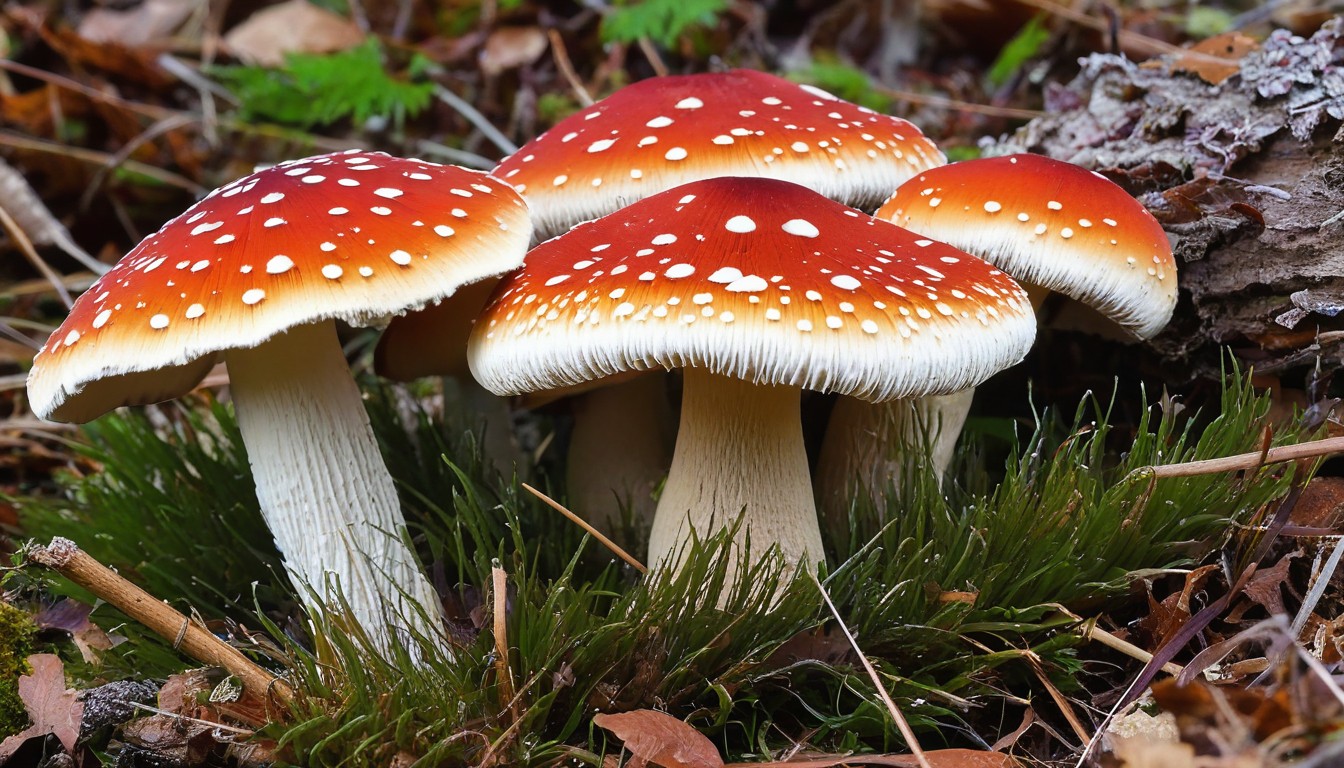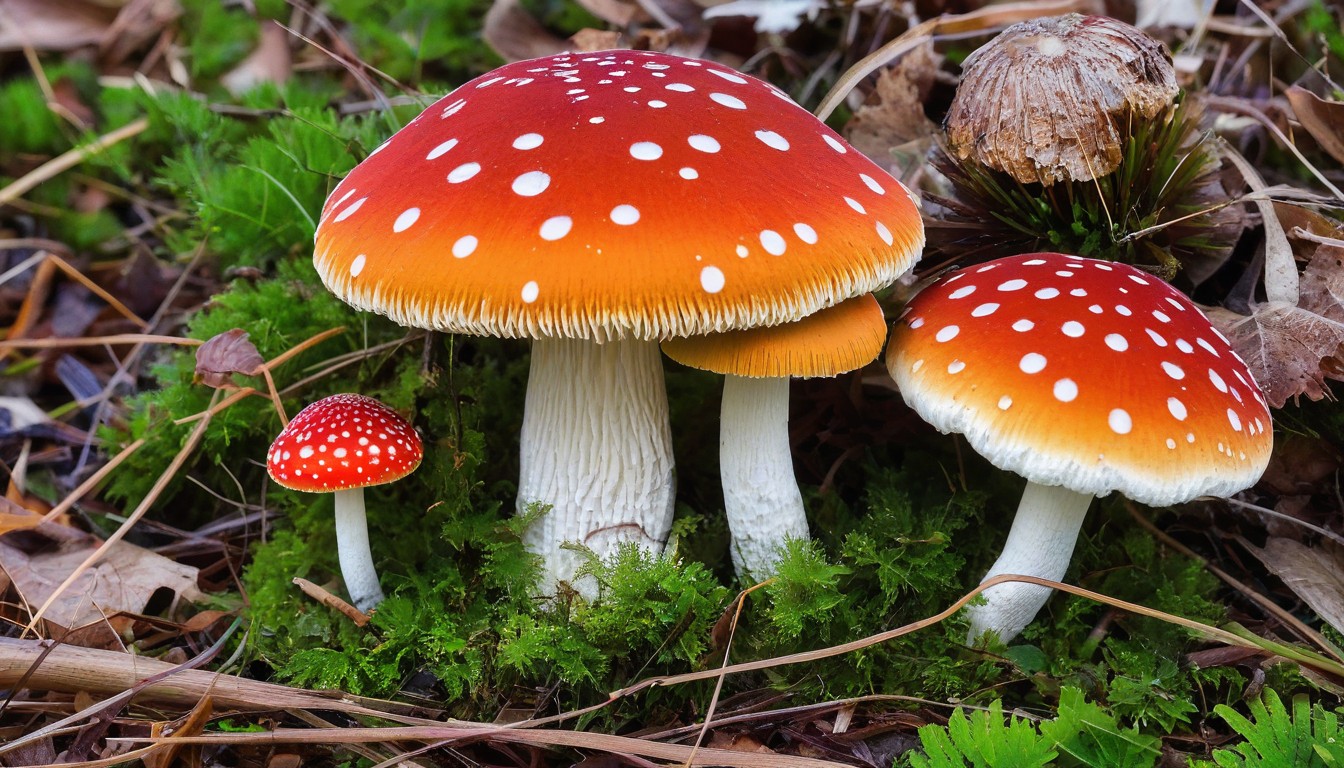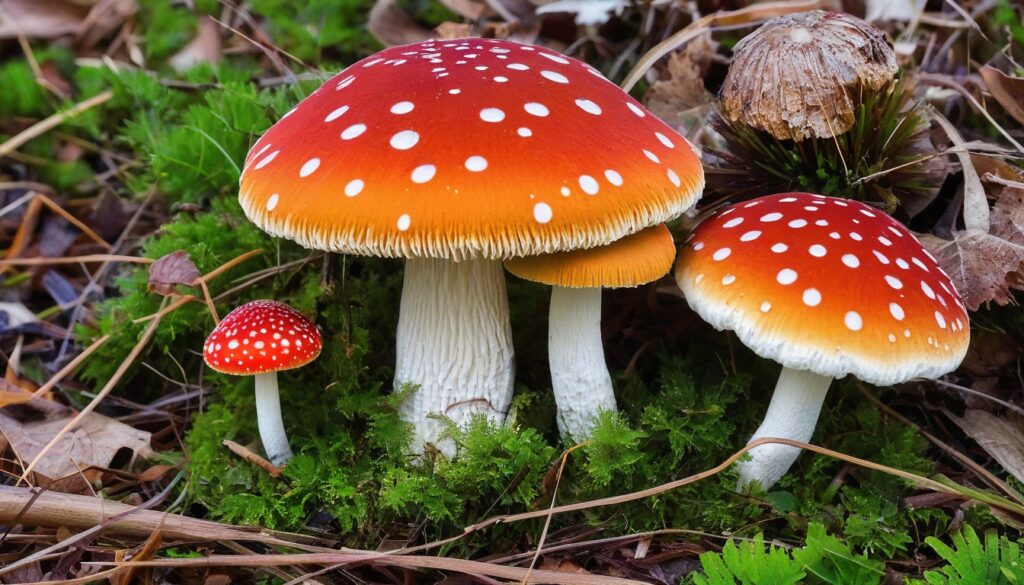If you enjoy the ancient tradition of mushroom foraging, you must stay aware of the potential dangers lurking in the Kansas area. While mushroom hunting might seem like a harmless pastime, the discovery of a poisonous mushroom can lead to serious consequences. In this guide, we will take you through Kansas’ mushroom kingdom, highlighting the characteristics of poisonous mushrooms and how to identify them.
Key Takeaways:
- Knowing which mushroom species are potentially hazardous is crucial for foragers
- Identifying dangerous mushrooms can be difficult
- It is essential to prioritize safety when foraging in Kansas
- Common visual cues and scent odors can help differentiate between poisonous and non-poisonous mushrooms
- Opting for edible alternatives can provide a safer and more pleasant foraging experience
Common Types of Poisonous Mushrooms in Kansas
When it comes to foraging for mushrooms in Kansas, it’s essential to know which ones to avoid as some species can be dangerously poisonous. In the following table, we’ll introduce you to some of the most common types found in Kansas:
Mushroom Name | Appearance | Characteristics |
|---|---|---|
Destroying Angel | A white mushroom with a smooth cap and skirt-like ring on the stem | One of the most toxic mushrooms in North America, containing amatoxins that attack the liver and kidneys |
Common Ink Cap | A tall, thin mushroom with a black, conical cap and white stem | Contains coprine, which can cause disulfiram-like reactions with alcohol, vomiting, and diarrhea |
False Morel | A lumpy, brain-shaped mushroom that can be red, brown, or yellow in color | Contains monomethyl hydrazine, a toxin used in rocket fuel that can cause liver and kidney damage, dizziness, seizures, and even death |
These are just a few examples of the dangerous mushrooms that grow in Kansas. The best way to stay safe is to avoid consuming any mushroom unless you’re 100% sure it is safe.
While the above table highlights some of the most common types of poisonous mushrooms in Kansas, it is by no means exhaustive, and there are many other species to steer clear of, including:
- Webcaps
- Death Caps
- Panther Caps
- Fly Agarics
Knowing what to look for is crucial when it comes to differentiating between poisonous and non-poisonous mushrooms. In the next section, we’ll provide you with more information on identifying these potentially dangerous fungi.
Toxicity Levels and Symptoms

Poisonous mushrooms can contain various levels of toxins, which can affect the human body differently. It’s essential to understand the toxicity levels and associated symptoms to avoid potential harm while foraging in Kansas.
Levels of Toxicity
There are three main levels of mushroom toxicity:
- Category A: These mushrooms cause severe symptoms and can be fatal. Eating even a small amount can have life-threatening consequences.
- Category B: These mushrooms can cause moderate to severe symptoms, and in some cases, can also be fatal. The amount ingested can affect the severity of symptoms.
- Category C: These mushrooms have mild to moderate effects and are usually not fatal, but can still cause discomfort and other unpleasant symptoms.
Symptoms
Toxicity Level | Symptoms |
|---|---|
Category A |
|
Category B |
|
Category C |
|
It’s important to note that symptoms may vary depending on the individual’s age, medical condition, and the amount of the toxic substance ingested. If you experience any symptoms after consuming or handling mushrooms, seek medical attention immediately.
Visual Identification Tips

Mushroom foraging can be a delightful pastime, but it’s crucial to identify potentially hazardous mushrooms. Here are some expert tips to help you visually differentiate between poisonous and non-poisonous mushrooms in Kansas:
- Pay attention to the cap: The cap is the top part of the mushroom. It can be flat, convex, or conical; however, poisonous caps may be slimy, sticky, or scaly. Look for variations in color, shape, and texture to help you identify a poisonous mushroom.
- Examine the stem: Poisonous mushrooms in Kansas can be identified by their stem. They may be thin and brittle, with a ring or veil near the top. Unlike non-poisonous mushrooms, which have tough, flexible stems.
- Check the gills: The gills are the thin strips of flesh beneath the cap. Poisonous gills are sometimes brittle and may be attached to the stem rather than the cap. Non-poisonous mushrooms have more durable gills that are usually unattached to the stem.
- Smell the mushroom: Identifying a mushroom’s odor is another way to differentiate between toxic and non-toxic mushrooms in Kansas. Non-poisonous mushrooms often have mild or earthy scents, while poisonous ones can be fishy, pungent, or unpleasant.
By using these visual identification tips, you can stay safe and avoid hazardous mushrooms while foraging in Kansas. Remember, if you’re not sure about a mushroom’s identification, it’s better to err on the side of caution and avoid it!
Scent and Odor Cues
When it comes to identifying poisonous mushrooms in Kansas, the scent and odor can often provide valuable clues. The aroma and fragrance of certain mushrooms can be quite distinct and can help differentiate between poisonous and non-poisonous varieties.
Here are some common scent and odor cues to look out for:
Scent/ Odor | Potential Mushroom |
|---|---|
Foul or putrid smell | Death Cap mushroom |
Almond smell | Bitter Almond mushroom |
Anise scent | Anise Cap mushroom |
Remember, relying solely on scent to identify poisonous mushrooms is not recommended. However, when used in combination with other identification methods, it can be a valuable tool to keep you safe while foraging.
Keep in mind that not all poisonous mushrooms have a strong odor, and not all scented mushrooms are poisonous. Always exercise caution and ensure you are 100% confident in your identification before consuming any mushrooms you have foraged.
Mycotoxin Presence and Effects

When it comes to poisonous mushrooms, mycotoxins are a significant concern. These toxic substances, produced by certain fungi, can have severe health implications for humans if ingested or handled.
In Kansas, some of the most commonly found mycotoxins in poisonous mushrooms include amanitin and muscarine. Amanitin, found in the deadly Amanita phalloides mushroom, can cause severe liver and kidney damage and even death in some cases. Muscarine, found in species such as Clitocybe and Inocybe, can cause symptoms such as sweating, salivating, and blurred vision.
It’s important to note that the symptoms of mycotoxin poisoning can vary depending on the type of toxin and the amount ingested. Some common symptoms include nausea, vomiting, abdominal pain, and diarrhea, among others. In severe cases, these symptoms can progress to liver and kidney failure, coma, and death.
If you suspect you may have ingested toxic mushrooms or have come into contact with poisonous mushrooms containing mycotoxins in Kansas, seek medical attention immediately. Proper identification of poisonous mushrooms is critical, as is knowing how to safely handle and dispose of them to prevent accidental exposure.
Tips for Safe Foraging
When it comes to mushroom foraging, safety should be your top priority. Follow these expert tips and precautions to ensure your foraging experiences in Kansas remain enjoyable and risk-free:
1. Educate Yourself
Before foraging, educate yourself on the types of poisonous mushrooms that can be found in Kansas and how to identify them visually. Attend a foraging workshop, read field guides, or learn from an expert to gain confidence in your knowledge.
2. Be Prepared
Carry a foraging knife, basket, and gloves with you. Use a cutting motion when harvesting mushrooms to avoid carrying dirt and debris into your basket. Also, bring a field guide, a compass, and a map of the area to keep yourself on track and avoid getting lost.
3. Know Your Location
Research the location where you plan to forage, and obtain permission from the landowner if necessary. Always forage in designated areas and avoid picking mushrooms near busy roads or industrial sites where they may have absorbed pollutants.
4. Mushroom Check
Thoroughly examine each mushroom you pick. Look for tell-tale signs of decay or insect infestation. Stay away from mushrooms with a slimy texture, spots, or a strong chemical odor.
5. Taste Testing
Never taste a mushroom unless you are 100% confident in your identification. Even small amounts of certain poisonous mushrooms can be fatal.
6. Storage and Transport
Store harvested mushrooms in a breathable container such as a paper bag in a cool environment. Avoid using plastic bags, which can trap moisture and accelerate decay. Transport mushrooms in a cooler with ice packs to help maintain freshness.
By following these tips and being mindful of your surroundings, you can safely enjoy the natural beauty and bounty of Kansas.
Edible Alternatives in Kansas

While it’s essential to be cautious when foraging for mushrooms, there are a variety of delicious and safe-to-consume options available in Kansas. Below, we have highlighted some edible alternatives you can confidently include in your foraging adventures:
Name | Description | Harvest Season |
|---|---|---|
Hen of the Woods | A firm and flavorful mushroom with a delicate texture, often found growing on the base of oak trees or stumps. | August to November |
Morels | A popular and highly-prized mushroom with a unique flavor profile and sponge-like texture. | April to May |
Chanterelles | A bright yellow or orange mushroom with a fruity aroma and delicate flavor, often found near pine trees or in damp areas. | June to September |
Lions Mane | A meaty, seafood-like mushroom with a unique texture and mild flavor, often found growing on hardwood trees. | July to September |
Remember, when foraging for mushrooms, it’s always important to err on the side of caution. If you’re uncertain about whether a mushroom is safe or not, don’t take the risk and leave it where it is. Stick to the edible alternatives we’ve highlighted above, and enjoy a safer and enjoyable foraging experience in Kansas.
Conclusion
Congratulations! You are now equipped with the knowledge and skills to identify and avoid poisonous mushrooms during your foraging adventures in Kansas. Remember, safety should be your top priority when exploring the fascinating world of fungi.
Always follow the guidelines and precautions we have outlined, and stay vigilant when identifying and handling mushrooms. If you are ever unsure about the safety of a particular mushroom, it’s best to err on the side of caution and avoid it.
While there are certain risks associated with mushroom foraging, there are also many safe and delicious options to explore in Kansas. With your newfound knowledge, you can confidently seek out edible alternatives and enjoy the thrill of the hunt without worry.
Thank you for taking the time to read this guide, and we wish you happy and safe foraging in the beautiful state of Kansas!
FAQ
How can I identify poisonous mushrooms in Kansas?
To identify poisonous mushrooms in Kansas, look for certain characteristics such as discolored caps, slimy or sticky texture, and the absence of a distinct mushroom smell. It is also essential to reference reliable field guides and consult with experienced mycologists if you are unsure.
What are some common types of poisonous mushrooms found in Kansas?
Kansas is home to several poisonous mushrooms, including the Death Cap (Amanita phalloides), Destroying Angel (Amanita bisporigera), and False Morels (Gyromitra spp.). These mushrooms are known for their toxic effects on humans and should be avoided.
What are the symptoms associated with consuming or handling poisonous mushrooms?
The symptoms of mushroom poisoning can vary depending on the type of mushroom involved. Common symptoms include nausea, vomiting, diarrhea, abdominal pain, hallucinations, and in severe cases, organ failure. If you experience any adverse effects after consuming mushrooms, seek medical attention immediately.
What tips can you provide for visually identifying poisonous mushrooms in Kansas?
When visually identifying poisonous mushrooms in Kansas, pay attention to features such as color variations, distinctive patterns, and the presence of warts or scales on the cap. It is crucial to note that some edible mushrooms may resemble poisonous ones, so always cross-reference your findings with reliable sources.
Can the scent or odor of mushrooms help in identifying poisonous mushrooms in Kansas?
Yes, the scent and odor of mushrooms can provide important clues in identifying poisonous mushrooms in Kansas. For instance, some toxic mushrooms may have a garlicky or almond-like smell, while others may emit a foul or unpleasant odor. However, relying solely on scent is not sufficient for accurate identification.
What are mycotoxins, and how do they affect humans when present in mushrooms?
Mycotoxins are toxic compounds produced by certain fungi, including some poisonous mushrooms. When present in mushrooms, mycotoxins can lead to various health issues ranging from mild gastrointestinal discomfort to severe liver damage and even death. It is essential to avoid consuming mushrooms with known mycotoxin presence.
What safety tips should I consider when foraging for mushrooms in Kansas?
When foraging for mushrooms in Kansas, it is crucial to follow these safety tips: – Only forage in areas you are familiar with and where mushroom collection is permitted. – Always carry a reliable field guide and consult with experienced foragers or mycologists. – Avoid consuming any mushroom unless you are certain of its identity. – Be cautious of poisonous look-alike mushrooms. – Cook all edible mushrooms thoroughly before consumption. – If in doubt, err on the side of caution and don’t consume the mushroom.
Are there any edible alternatives to poisonous mushrooms in Kansas?
Absolutely! Kansas is home to several safe-to-consume mushrooms, including Morel mushrooms (Morchella spp.), Chanterelles (Cantharellus spp.), and Chicken of the Woods (Laetiporus spp.). These edible mushrooms offer delicious flavors and can be a great addition to your foraging adventures in the state.

